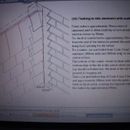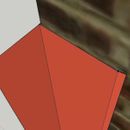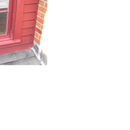Flashing between ends of clapboards and brick chimney at end of house?
Hi.
I live in a timber frame house built in 1991. External walls are SIPs. There is a brick chimney located at a gable end of the house. The ends of the clapboards on either side of the chimney butt up against a piece of vertical 1″x1″ which lays directly against the chimney bricks. It seems as though this arrangement really isn’t sufficient to keep water out of this location. There has been some water leakage into the porch which was added to this end of the house and encloses the 1st floor portion of the chimney. See attached photo.
Some searching of the Internet has only netted 2 approaches: 1) Install flashing vertically in the corner, 2) Install flashing into the chimney morter every few courses (see attached image for the concept),
I plan to remove the existing clapboard on that end of the house because I’m replacing two damaged windows. The current situation is that the clapboards are nailed directly to the SIPs’ OSB skins — there is no paper or building wrap! Yipes! Current specs for WinterPanel SIPs requires 1″ (3/4″) furring be added to the OSB for proper nail grip for the siding. Current specs also require an air gap. I plan to turn this wall into a rain screen, using clapboards again to match the rest of the house.
I’ve seen fairly good coverage of rain screen techniques on this site and JLC, but what is best way (or several very good ways) to deal with this pesky location where the chimney meets the end of the house?
Thanks,
Bill in Upton MA USA
GBA Detail Library
A collection of one thousand construction details organized by climate and house part













Replies
Bill,
最好的way to avoid this problem is to build an interior chimney. Exterior chimneys on the gable wall of a building have all kinds of problems. Cold flues don't draw as well as warm flues, and cold flues tend to encourage the condensation of moisture from flue gas.
However, it's too late for that advice to help you. I vote for the installation of metal flashing at this location. Use a heavy bead of silicone caulk to bed the leg of the metal flashing on the chimney side; the other leg of the flashing doesn't need caulk.
.
Thanks Martin.
Would you suggest using lead flashing, as in your photo, or would alum/copper be fine? Looks like perhaps a 3" leg on the brick side, give or take?
Lastly, why silicone instead of Polyurethane? The latter seems to be touted as the go-to caulk for longevity in external applications.
Bill,
I don't use lead flashing any more, because of toxicity concerns. (As you might have guessed, I grabbed the photo off the Web.)
Either copper, thick aluminum, or painted galvanized steel flashing would work fine. Although I mentioned silicone caulk, there is no reason you couldn't use polyurethane caulk.